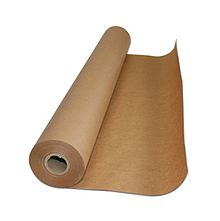Kraft paper
This article needs additional citations for verification. (October 2011) |

Kraft paper or kraft
Sack kraft paper (or just sack paper) is a porous kraft paper with high elasticity and high tear resistance, designed for packaging products with high demands for strength and durability.[2]
Pulp produced by the kraft process is stronger than that made by other
Kraft pulp is darker than other wood pulps, but it can be bleached to make very white pulp. Fully bleached kraft pulp is used to make high quality paper where strength, whiteness, and resistance to yellowing are important.
Manufacture

A paper sack can be made of several layers of sack paper depending on the toughness needed.
Kraft paper is produced on paper machines with moderate machine speeds. The raw material is normally softwood pulp from the kraft process.
Maintaining a high effective sulfur ratio or sulfidity is important for the highest possible strength using the kraft process.
The kraft process can use a wider range of fiber sources than most other pulping processes. All types of wood, including very resinous types like southern pine,[5] and non-wood species like bamboo and kenaf can be used in the kraft process.
Qualities
- Normal kraft paper is strong and relatively coarse. It has high tensile strength. The grammageis normally 40–135 g/m2.
- Sack kraft paper, or just sack paper, is a porous kraft paper with high elasticity and high tear resistance, designed for packaging products with high demands for strength and durability.
- Absorbent kraft paper is made with controlled absorbency (i.e. a high degree of porosity). It is made of clean low kappa hardwood kraft and has to have a good uniformity and formation.
- Spinning kraft paper is an especially strong type of kraft paper with relatively low grammage (40 g/m2). This paper requires the best possible machine direction strength and cross machine elongation. This is done by high fiber orientation on the paper machine.
- Hunting cartridge paper is a kraft paper used in shotgun shells. This paper needs a high tensile strength in the machine direction, which is the axial direction of the cartridges. In the cross direction, the cartridge is supported by the gun-pipe, but a sufficient elongation is needed. The body of the cartridge is wound of a kraft paper of 80–120 g/m2, which is further covered by an outer sheet of 60–80 g/m2 with colour and printing.
- Candy wrapping paper and twisting paper are thin 30–40 g/m2 kraft papers and are mostly supercalendered.
Applications

- As a plastic-hazard-free paper in paper sacksfor cement, food, chemicals, consumer goods, flour bags etc.
- Electrical insulation in large oil-filled transformers
- envelopesand other packaging
- An inexpensive material for lining particle boards
- The base paper for sandpaper
- As wrapping for flower bouquets
- In World War II, for fabricating drop tanks
- As a wrapping for the French dish Gigot bitume, which consists of a leg of lamb wrapped in Kraft paper and cooked in hot asphalt
See also
References
- ^ Derived from German Kraft,kraft meaning "strength" in this context, due to the strength of the paper produced using this process.
- ^ ISBN 952-5216-18-7.
- ^ Hubbe, Martin A.; Lucia, Lucian A. (2007). "The "Love-Hate" Relationship Present in Lignocellulosic Materials". BioResources. 2 (4): 534–535. Retrieved 2015-02-02.
- ^ Parris, N (2002). "Recyclable zein-coated kraft paper and linerboard" (PDF). Progress in Paper Recycling. 11 (3): 24–29. Retrieved 4 November 2019.
- ^ "The Southern Pines" (PDF). US Department of Agriculture. 1985. Archived from the original (PDF) on 2007-07-09. Retrieved 2007-09-13.
- Yam, K. L., Encyclopedia of Packaging Technology, John Wiley & Sons, 2009, ISBN 978-0-470-08704-6
External links
 Media related to Kraft paper at Wikimedia Commons
Media related to Kraft paper at Wikimedia Commons
